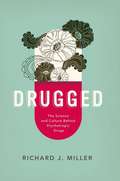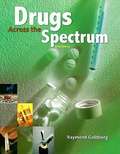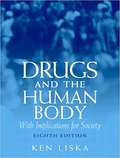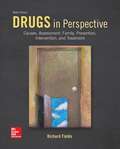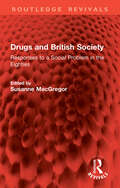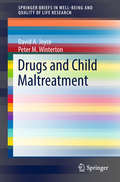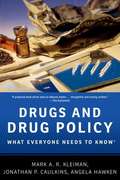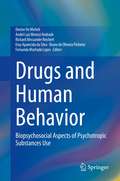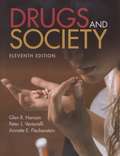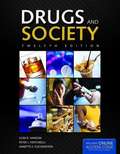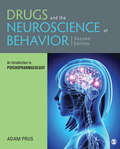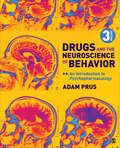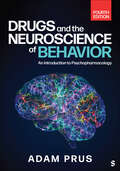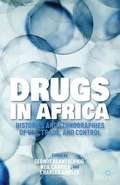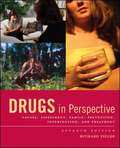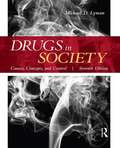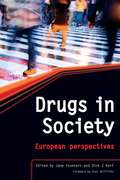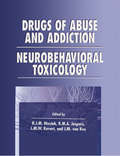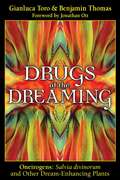- Table View
- List View
Drugged: The Science And Culture Behind Psychotropic Drugs
by Richard J. Miller"Morphine," writes Richard J. Miller, "is the most significant chemical substance mankind has ever encountered." So ancient that remains of poppies have been found in Neolithic tombs, it is the most effective drug ever discovered for treating pain. "Whatever advances are made in medicine," Miller adds, "nothing could really be more important than that." And yet, when it comes to mind-altering substances, morphine is only a cc or two in a vast river that flows through human civilization, ranging LSD to a morning cup of tea. In DRUGGED, Miller takes readers on an eye-opening tour of psychotropic drugs, describing the various kinds, how they were discovered and developed, and how they have played multiple roles in virtually every culture. The vast scope of chemicals that cross the blood-brain barrier boggle the very brain they reach: cannabis and cocaine, antipsychotics and antidepressants, alcohol, amphetamines, and Ecstasy-and much more. Literate and wide-ranging, Miller weaves together science and history, telling the story of the undercover theft of 20,000 tea plants from China by a British spy, for example, the European discovery of coffee and chocolate, and how James Wolfgang von Goethe, the famous man of letters, first isolated the alkaloid we now know as caffeine. Miller explains what scientists know-and don't-about the impact of each drug on the brain, down to the details of neurotransmitters and their receptors. He clarifies the differences between morphine and heroin, mescaline and LSD, and other similar substances. Drugged brims with surprises, revealing the fact that antidepressant drugs evolved from the rocket fuel that shot V2 rockets into London during World War II, highlighting the role of hallucinogens in the history of religion, and asking whether Prozac can help depressed cats. Entertaining and authoritative, Drugged is a truly fascinating book.
Drugs Across the Spectrum (6th edition)
by Raymond GoldbergIn this undergraduate textbook, Goldberg (State U. of New York at Cortland) surveys the physiological, psychological, and sociological literature on the use and abuse of licit and illicit drugs. Opening chapters provide an overview of drugs in contemporary society, motivations for drug use, drugs and the law, and the pharmacology and physiology of drug use. The psychological and physiological effects of drugs are then explored in individual chapters covering alcohol; tobacco; narcotics; sedative-hypnotic drugs; psychotherapeutic drugs; stimulants (cocaine, amphetamines, and caffeine); marijuana; and over-the-counter drugs. A final pair of chapters summarizes the research on substance abuse treatment and drug prevention and education. Annotation ©2005 Book News, Inc., Portland, OR (booknews.com)
Drugs And The Human Body
by Ken LiskaClear and readable for the average reader – yet comprehensive enough for the professional – this reliable reference addresses the effects of high-use, high-abuse drugs in America in a timely and straightforward fashion. Reflects up-to-date research throughout, including coverage of street, over-the-counter, and prescriptive drugs. Highlights the World Wide Web as a growing primary source of drug information. Extensively revises coverage of drug discovery, including major additional information on proteomics, and pharmacogenomics; and highlights the importance of these topics in the context of personalized drug treatment. For professionals in health and drug education, criminal justice, sociology, biology, and chemistry.
Drugs In Perspective: Causes, assessment, family, prevention, intervention, and treatment
by Richard FieldsDrugs in Perspective is a compilation of useful reports, case studies, and literature on drugs and alcohol--their use, abuse, and addiction. Backed by more than 30 years of clinical experience with clients, Dr. Richard Fields provides a comprehensive framework to understand substance abuse. The 9th edition includes ample case studies, up-to-date information on treatment and recovery, and a new chapter dedicated to relapse, prevention, and mindfulness.
Drugs and British Society: Responses to a Social Problem in the Eighties (Routledge Revivals)
by Susanne MacGregorFirst published in 1989, Drugs and British Society (now with a new preface by Susanne MacGregor) provides information on the drugs problem in Britain in the 1980s, based on extensive research and experience, and places it in its international and historical context.The contributors to this book are all experts in this field, and are drawn from a range of disciplines, including epidemiology, sociology, social psychiatry, social policy, anthropology, and history. They share a social rather than a narrowly medical or individualistic perspective on drugs, stressing that policy and practice about drugs must be based not on prejudice, alarm or outdated ideas, but on clear, reliable and detailed evidence and the informed judgements of people who have a thorough understanding of the issues. They explain the problem by referring it to its social and political context, from the level of the local community and local services to the wider national and structural levels.
Drugs and Child Maltreatment (SpringerBriefs in Well-Being and Quality of Life Research)
by David A. Joyce Peter M. WintertonThis book combines experience in child protection with expertise in clinical pharmacology and forensic toxicology, to set out a broad contemporary understanding of child maltreatment with drugs. It explores presentations that range through ante-natal exposure, factitious illness, deliberate poisoning, drug accidents while in the care of drug-affected adults, misuse of therapeutic drugs and the drug-related death of a child. It describes how to recognise where deliberate drug exposure or perversion of proper therapeutics is being used to harm a child, how to use laboratory testing to confirm a diagnosis, how to combine medical and social care with the need to gather legal evidence and how to deploy social, medical and legal resources for child protection. The roles of the forensic toxicologist and contemporary forensic laboratory methods in resolving cryptic presentations are discussed in each context. There is guidance on effective communication about drugs within the child protection team and on writing reports for legal purposes, on the way to returning the child to safety. The book also explores the particular difficulties that arise in reconciling parents' rights and cultural beliefs with the obligation to document a child’s drug exposure and in dealing with parents and carers who themselves may be drug-impaired.
Drugs and Drug Policy: What Everyone Needs to Know
by Mark A. R. Kleiman Jonathan P. Caulkins Angela HawkenWhile there have always been norms and customs around the use of drugs, explicit public policies - regulations, taxes, and prohibitions - designed to control drug abuse are a more recent phenomenon. Those policies sometimes have terrible side-effects: most prominently the development ofcriminal enterprises dealing in forbidden (or untaxed) drugs and the use of the profits of drug-dealing to finance insurgency and terrorism. Neither a drug-free world nor a world of free drugs seems to be on offer, leaving citizens and officials to face the age-old problem: What are we going to do about drugs? In Drugs and Drug Policy, three noted authorities survey the subject with exceptional clarity, in this addition to the acclaimed series, What Everyone Needs to Know. They begin by, defining "drugs," examining how they work in the brain, discussing the nature of addiction, and exploring the damage they do to users. The book moves on to policy, answering questions about legalization, the role of criminal prohibitions, and the relative legal tolerance for alcohol and tobacco. The authors then dissect the illicit trade, from street dealers to the flow of money to the effect of catching kingpins,and show the precise nature of the relationship between drugs and crime. They examine treatment, both its effectiveness and the role of public policy, and discuss the beneficial effects of some abusable substances. Finally they move outward to look at the role of drugs in our foreign policy, their relationship to terrorism, and the ugly politics that surround the issue. Crisp, clear, and comprehensive, this is a handy and up-to-date overview of one of the most pressing topics in today's world.
Drugs and Human Behavior: Biopsychosocial Aspects of Psychotropic Substances Use
by André Luiz Monezi Andrade Eroy Aparecida da Silva Denise De Micheli Fernanda Machado Lopes Bruno de Oliveira Pinheiro Richard Alecsander ReichertThis book presents the main concepts and tools for the adoption of a biopsychosocial approach to psychotropic substances use and abuse management, prevention and treatment. It aims to provide resources for the design and implementation of health strategies and public policies to deal with psychotropic substances use in a way that fully recognizes the complex articulations between its biological, psychological and social aspects, taking these three dimensions into account to develop both health and social care policies and strategies aimed at psychotropic substance users. The book is organized in five parts. Part one presents a historical overview of psychotropic substances use throughout human history and introduces key concepts to understand the phenomenon from a biopsychosocial perspective. The next three parts approach psychotropic substances use from one of the interrelated dimensions of the biopsychosocial perspective: part two focuses on the neurobiological aspects; part three, on the psychological aspects; and part four, on the social aspects and its implications for public policy design. Finally, a fifth part is dedicated to special topics related to psychotropic substances use. Drugs and Human Behavior: Biopsychosocial Aspects of Psychotropic Substances Use is a guide to public agents, health professionals and social workers interested in adopting the biopsychosocial perspective to develop and implement both health and social care strategies and policies based on an interdisciplinary approach and aimed at dealing with psychotropic substance users in a more humanized way.
Drugs and Society
by Glen R. Hanson Annette E. Fleckenstein Peter J. VenturelliThoroughly revised and updated, Drugs and Society, Eleventh Edition, contains the most current information available concerning drug use and abuse. Written in an objective and user-friendly manner, this best-selling text continues to captivate students by taking a multidisciplinary approach to the impact of drug use and abuse on the lives of ordinary people. The Eleventh Edition incorporates the authors#146; combined expertise in pharmacology, drug abuse, and sociology and extensive experience in research, teaching, drug policy-making, and drug policy implementation and includes hundreds of new citations that reflect the current state of drug abuse issues and the rapidly changing issues of substance abuse/addiction.
Drugs and Society
by Glen R. Hanson Annette E. Fleckenstein Peter J. VenturelliUpdated to keep pace with the latest data and statistics, Drugs and Society, Twelfth Edition, contains the most current information available concerning drug use and abuse. Written in an objective and user-friendly manner, this best-selling text continues to captivate students by taking a multidisciplinary approach to the impact of drug use and abuse on the lives of average individuals.
Drugs and Society
by Glen R. Hanson Peter J. Venturelli Peter PlatteborzeAs a long-standing, reliable resource Drugs & Society, Fifteenth Edition continues to captivate and inform students by taking a multidisciplinary approach to the impact of drug use and abuse on the lives of average individuals. The authors have integrated their expertise in the fields of drug abuse, pharmacology, and sociology with their extensive experiences in research, treatment, drug policy making, and drug policy implementation to create an edition that speaks directly to students on the medical, emotional, and social damage drug use can cause. Updated throughout to reflect the recent data and legislation, the 15th Edition also offers: Updated coverage of prohibition, Harrison Tax Act, and other laws that have had an significant impact on special populations. A greater emphasis on alcohol use and sexual abuse, marital and spouses abuse, and other major crimes committed. Discussion of the relationship between alcohol and health problems associated with the abuse of alcohol
Drugs and the Neuroscience of Behavior: An Introduction to Psychopharmacology
by Adam PrusDrugs and the Neuroscience of Behavior: An Introduction to Psychopharmacology, Second Edition by Adam Prus presents an introduction to the rapidly advancing field of psychopharmacology by examining how drug actions in the brain affect psychological processes. The book provides historical background to give readers an appreciation for the development of drug treatments and neuroscience over time, covering major topics in psychopharmacology, including new drugs and recent trends in drug use. Pedagogical features informed by the latest scholarship in teaching and learning are integrated throughout the text to ensure that readers are able to process and understand the material with ease.
Drugs and the Neuroscience of Behavior: An Introduction to Psychopharmacology
by Adam PrusDrugs and the Neuroscience of Behavior: An Introduction to Psychopharmacology, Second Edition by Adam Prus presents an introduction to the rapidly advancing field of psychopharmacology by examining how drug actions in the brain affect psychological processes. The book provides historical background to give readers an appreciation for the development of drug treatments and neuroscience over time, covering major topics in psychopharmacology, including new drugs and recent trends in drug use. Pedagogical features informed by the latest scholarship in teaching and learning are integrated throughout the text to ensure that readers are able to process and understand the material with ease.
Drugs and the Neuroscience of Behavior: An Introduction to Psychopharmacology
by Adam PrusDrugs and the Neuroscience of Behavior presents an introduction to the rapidly advancing field of psychopharmacology by examining how drug actions in the brain affect psychological processes. Author Adam Prus provides historical background to give readers an appreciation for the development of drug treatments and neuroscience over time, covering major topics in psychopharmacology including new drugs and recent trends in drug use. Empirically supported pedagogical features offer students the opportunity to reflect on what they read to ensure understanding before progressing to new content. The Third Edition includes a new chapter on depressants and discussions of major topics such as the opioid epidemic, the risks associated with vaping, and MDMA-assisted psychotherapy for PTSD. Included with this title: The password-protected Instructor Resource Site (formally known as SAGE Edge) offers access to all text-specific resources, including a test bank and editable, chapter-specific PowerPoint® slides.
Drugs and the Neuroscience of Behavior: An Introduction to Psychopharmacology
by Adam PrusDrugs and the Neuroscience of Behavior presents an introduction to the rapidly advancing field of psychopharmacology by examining how drug actions in the brain affect psychological processes. Author Adam Prus provides historical background to give readers an appreciation for the development of drug treatments and neuroscience over time, covering major topics in psychopharmacology including new drugs and recent trends in drug use. Empirically supported pedagogical features offer students the opportunity to reflect on what they read to ensure understanding before progressing to new content. The Third Edition includes a new chapter on depressants and discussions of major topics such as the opioid epidemic, the risks associated with vaping, and MDMA-assisted psychotherapy for PTSD. Included with this title: The password-protected Instructor Resource Site (formally known as SAGE Edge) offers access to all text-specific resources, including a test bank and editable, chapter-specific PowerPoint® slides.
Drugs and the Neuroscience of Behavior: An Introduction to Psychopharmacology
by Adam PrusDrugs and the Neuroscience of Behavior is a highly current introduction to psychopharmacology that provides broad and accessible coverage suitable for undergraduate students without a strong background in neuroscience. Author Adam Prus integrates approachable descriptions of drug action with historical context to help readers understand the evolution of drug treatments and usage up to the current day. The Fourth Edition reflects a variety of developments including changes in the usage of nicotine and Delta-8-THC, additional clinical applications of psychedelics and gabapentin, and the discovery of new treatments for mental disorders using novel pharmacological approaches. In addition, the book includes updated statistics, changes in international law, and new information from DSM-5-TR. Finally, the author′s engaging writing style and empirically supported pedagogy make this a highly engaging and enjoyable introduction to the subject. KEY FEATURES: The coverage of alcohol now includes a new understanding of the risks and effects of alcohol consumption, including the J-shaped curve representing a hazard ratio, alcohol-induced neurodegeneration, hepatic encephalopathy, effects on sleep, and more. The coverage of nicotine features new information about the increased use of tobacco pouch products, the adverse acute effects of vaping, understanding menthol and its impact on nicotine absorption, and new statistics on second hand smoke exposure. Delta-8-THC is also discussed for the first time. Chapter 12: Psychedelic Drugs has been overhauled to reflect the rapidly advancing development of new treatments and applications. It includes a new classification of drugs as serotonergics, glutaminergics, or entactogens. Chapter-opening outlines and learning objectives prepare students for forthcoming material and identify what they should be able to accomplish upon completion of the reading. From Actions to Effects sections provide focus on a topic drawing from multiple chapter concepts to boost conceptual understanding of how the actions of a drug produce its effects. Stop & Check questions concluding each section in every chapter allow students to assess their own understanding of main points covered in the previous section. Review! callouts serve as important reminders of information covered in previous chapters to help students make connections and understand new concepts. Drug Profiles provide basic information about a key compound and include a drug’s generic name, trade name and/or street name, and a description of its pharmacological actions. Research Techniques and Methods boxes cover a research technique or method used in psychopharmacology research and serve as an easy reference when students come across research findings derived from each technique. Chapter-ending summaries and key terms allow readers to review and reinforce the material.
Drugs and the Neuroscience of Behavior: An Introduction to Psychopharmacology
by Adam PrusDrugs and the Neuroscience of Behavior: An Introduction to Psychopharmacology offers a highly current and accessible overview of the fundamental concepts and principles of psychopharmacology. Author Adam Prus integrates approachable descriptions of drug action with historical context to help students understand the evolution of drug treatments and usage up to the current day. The Fourth Edition reflects a variety of developments including changes in the usage of nicotine and Delta-8-THC, additional clinical applications of psychedelics and gabapentin, and the discovery of new treatments for mental disorders using novel pharmacological approaches. Additionally, it incorporates updated statistics, changes in international law, and new information from DSM-5-TR.
Drugs in Africa
by Gernot Klantschnig Neil Carrier Charles AmblerThis cutting-edge volume is the first to address the burgeoning interest in drugs and Africa among scholars, policymakers, and the general public. It brings together an interdisciplinary group of leading academics and practitioners to explore the use, trade, production, and control of mind-altering substances on the continent
Drugs in American Society
by Erich GoodeDrugs in American Society is a sociological introduction to the use of psychoactive substances in the United States that takes a big-picture look at patterns of drug consumption in America while also focusing on the effects that drugs have on the lives of users. Significantly streamlined and reorganized, this tenth edition presents the most current research, data, and statistics on drug use and discusses the latest trends involving drugs, from the decriminalization and mainstreaming of marijuana to the opiate epidemic that has led to a startling rise in overdose deaths. Personal accounts of Americans that have taken drugs are provided to show the reality of drug use and provide insights that go beyond the portrayal of drugs in society and the news media.
Drugs in Perspective (7th edition)
by Richard FieldsThis text is designed for the drug and substance abuse counseling course that prepares future health professionals to work with patients, clients, and families of abusers.
Drugs in Society: Causes, Concepts, and Control
by Michael D. LymanThis work focuses on the many critical areas of America's drug problem, providing a foundation for rational decision making within this complex and multidisciplinary field. Broken up into three sections, Understanding the Problem, Gangs and Drugs, and Fighting Back, topics covered include the business of drugs and the role of organized crime in the drug trade, drug legalization and decriminalization, legal and law enforcement strategies, an analysis of the socialization process of drug use and abuse, and a historical discussion of drug abuse that puts the contemporary drug problem into perspective.
Drugs in Society: The Epidemiologically Based Needs Assessment Reviews, Vols 1 & 2
by Jane Fountain David Elliman Dirk J KorfThis title includes Foreword by Paul Griffiths, Scientific Coordinator, European Monitoring Centre for Drugs and Drug Addiction (EMCDDA), Portugal. "Provocative. Stimulating. Reflect[s] the diverse and eclectic nature of drug use in Europe and, in doing so, makes for a rich reading experience. This book is about drug use as a dynamic social behaviour where understanding meaning and motivations, and culture and context, are as important as understanding the actions of chemicals on the brain or body. It clearly illustrates the value of social research as a powerful tool for illuminating subjects that are too often overlooked in the discourse on the drug problem, but also reminds us why such a detailed vision is important." "If you are feeling jaded and uninspired, and have forgotten why this topic ever interested you in the first place; if you simply want to read something provocative and different that reminds you of why the use of drugs is not only an important policy issue but also a fascinating area for social research - this book is for you - and these seem to me pretty good reasons for recommending a text." - Paul Griffiths, in the Foreword.
Drugs of Abuse and Addiction: Neurobehavioral Toxicology
by R J.M. Niesink R.M.A. Jaspers,Drugs of Abuse and Addiction: Neurobehavioral Toxicology examines drugs of abuse and addiction and how they affect behavior. This book considers the entire range of addiction research in humans and animals, using a multidisciplinary approach to discuss all areas of the neuro- and behavioral sciences involved. Emphasis is on acute and chronic effect
Drugs of the Dreaming: Salvia divinorum and Other Dream-Enhancing Plants
by Benjamin Thomas Gianluca Toro Jonathan OttThe first comprehensive guide to oneirogens--naturally occurring substances that induce and enhance dreaming • Includes extensive monographs on dream-enhancing substances derived from plant, animal, and human sources • Presents the results of scientific experiments on the effects of using oneirogens • Shows how studies in this area of ethnobotany can yield a scientific understanding of the mysterious mechanism of dreams Oneirogens are plant and animal substances that have long been used to facilitate powerful and productive dreaming. From the beginning of civilization, dreams have guided the inner and outer life of human beings both in relation to each other and to the divine. For centuries shamans have employed oneirogens in finding meaning and healing in their dreams. Drugs of the Dreaming details the properties and actions of these dream allies, establishing ethnobotanical profiles for 35 oneirogens, including those extracted from organic sources--such as Calea zacatechichi (dream herb or “leaf of the god”), Salvia divinorum, and a variety of plants from North and South America and the Pacific used in shamanic practices--as well as synthetically derived oneirogens. They explain the historical use of each oneirogen, its method of action, and what light it sheds on the scientific mechanism of dreaming. They conclude that oneirogens enhance the comprehensibility and facility of the dream/dreamer relationship and hold a powerful key for discerning the psychological needs and destinies of dreamers in the modern world.
Drugs, Addiction, And The Law: Policy, Politics, And Public Health
by Peter J. CohenAmerican physician and attorney Cohen discusses legal, ethical, and policy considerations faced by society as it deals with psychoactive drug use. A recurring theme is the need to balance individual liberty and autonomy with the needs of society. None of the several models that have been devised to that end is completely satisfying, he says, and all of them raise important questions. The book cites legislation and court decisions extensively.
